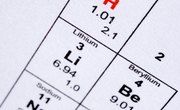
A neutralization equation is a chemical reaction that involves the combination of a strong acid and a strong base. The products of such a reaction are typically water and a salt. It is useful to know how to solve neutralization equations because they are often involved in chemistry experiments and they can help you to better understand the differences between acids and bases. Tables of strong acids and bases are often provided for reference.
- Periodic table
- Computer
- Chemistry book
- Pen
- Paper
Write down the chemical formulas for the strong acid and the strong base that are the reactants of the neutralization equation. The problem will usually tell you what the reactants are. For example, the problem may state that hydrochloric acid and sodium hydroxide react with one another. The chemical formula for hydrochloric acid is HCl and the chemical formula for sodium hydroxide is NaOH.
Analyze the reactants and determine which is the strong acid and which is the strong base. If the problem does not specify which is which, then you can find out by looking at a table of strong acids and bases online or in a chemistry book. In the problem with the HCl and the NaOH, the HCl is the strong acid and the NaOH is the strong base.
Determine which type of reaction is occurring within the neutralization equation. Most of the time, the reaction is a double displacement reaction. This means that one of the elements or compounds of the one of the reactants combines with an element or compound of the other reactant. For example, if HCl and NaOH are the reactants, then the H of the HCl combines with the OH in the NaOH, and the Cl combines with the Na.
Write out the entire neutralization reaction. For example, the reaction with the hydrochloric acid and the sodium hydroxide gives you HCl + NaOH gives you H2O + NaCl.
Balance the chemical equation. Balancing the neutralization reaction involves the process of making sure that there is an equal number of moles of each of the elements on both sides of the equation. The neutralization equation of HCl + NaOH gives you H2O + NaCl is already balanced because there are two moles of H on both sides, one mole of Cl on both sides, one mole of Na on both sides, and one mole of O on both sides.
Things You'll Need
References
About the Author
Mara Pesacreta has been writing for over seven years. She has been published on various websites and currently attends the Polytechnic Institute of New York University.
Photo Credits
BananaStock/BananaStock/Getty Images
